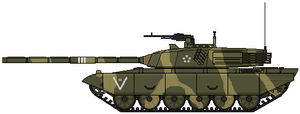T2 Toro
| T2 Toro | |
|---|---|
 A T2A of the 11th Armoured Brigade | |
| Type | main battle tank |
| Place of origin | |
| Service history | |
| In service | 2010-present |
| Used by | |
| Production history | |
| Designer | Design Bureau of the Jinjŏng Chŏlgang-Nodongja Vehicle Plant Alcaron Vehicle Design Office |
| Designed | 2007-2010 |
| Produced | 2009 |
| No. built | 400+ |
| Specifications | |
| Weight | 51.2 metric tonnes |
| Length | 9.68 m overall 7.23 m hull only |
| Width | 3.77 m including side armor |
| Height | 2.27 m to turret roof |
| Crew | 3 (driver, gunner, commander) |
| Armor | Welded steel base Composite armor (turret face and hull glacis) Escudo ERA (T2M1) |
Main armament | 125mm Espada CM99 smoothbore gun |
Secondary armament | 12.7mm GCh-75Ch HMG (commander) 7.62mm GCh-77 MMG (co-axial) |
| Engine | Alcaron MDP500 diesel 1,250 hp |
| Suspension | torsion-bar |
| Ground clearance | 43 cm |
Operational range | 850 km (internal fuel) |
| Speed | 65 km/h (road) |
The T2 Toro (Sylvan for Bull) is an Idacuan main battle tank based on the Menghean JCh-6. After receiving a batch of JCh-6Gs from Menghe, the Idacuan government was so satisfied with the tank's performance that it expressed the desire to make a local variant of the vehicle. The project was approved, and after the prototype trials, serial production began in 2010 with the baseline T2 model. The project spawned two more upgraded variants, the T2M1 and T2M2, the latter of which entered service in 2018. Currently, the T2 serves as the Idacuan Revolutionary Army's frontline main battle tank, with over 400 units in service.
Development
The stagnant economy of Idacua in the immediate years after the 1986 Revolution had left the Army with very little funds to procure new equipment. The Idacuan Revolutionary Army's tank force had been largely obsolete by the 1990s, composed mostly of Sieuxerrian AMX-30 main battle tanks and AMX-13 light tanks. The recovery of the economy on the turn of the century, however, brought new opportunities for modernization. In 2003, a contract was signed with the Letnian government for the delivery of 200 T-74B main battle tanks. However, the introduction of the Menghean JCh-6 in 2004 caught the attention of the Idacuan government, who felt that the Menghean vehicle was more suited to local needs. After cancelling the Letnian tank order, the government entered talks with their Menghean counterparts to acquire JCh-6G units. However, the Mengheans claimed that the vehicle contained classified technologies that they weren't prepared to export. As such, talks were cancelled and the Idacuan Army remained with an outdated tank force for the next few years.
With the introduction of the upgraded JCh-6N variant in 2006, talks for the procurement of G version vehicles started again. This time, the negotiation bore fruit and an order for 100 JCh-6Gs was placed. Deliveries were completed by by early 2007, and the Idacuan military leadership was satisfied with the vehicles, with 100 more being delivered. The satisfactory performance of the JCh-6G and the desire of the government's desire to develop a self sufficient military industry drove the Idacuans into new negotiations to acquire a license for the local production and modification of the tank, which they acquired by the end of the year.